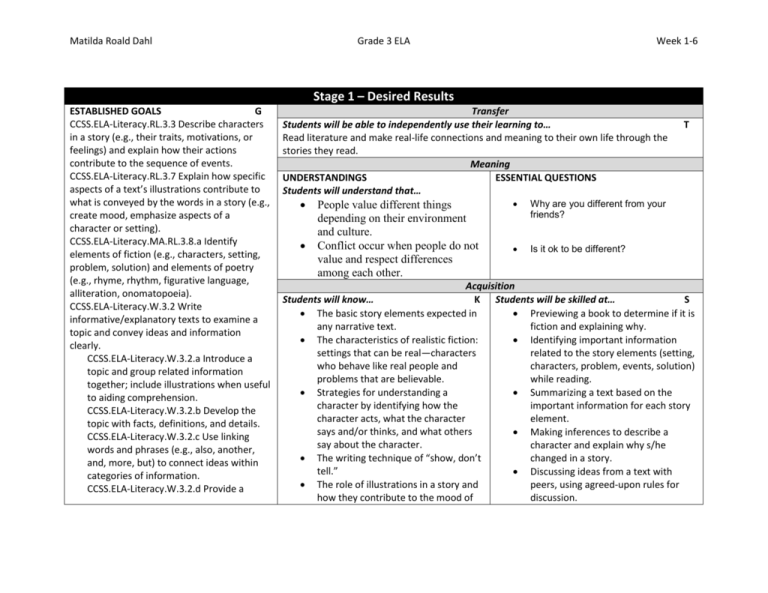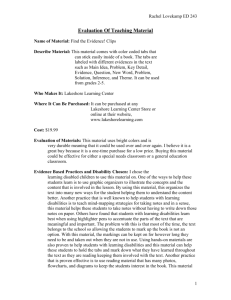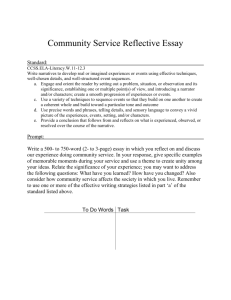ELA - Grade 4 Merlins
advertisement

Matilda Roald Dahl Grade 3 ELA Week 1-6 Stage 1 – Desired Results ESTABLISHED GOALS G CCSS.ELA-Literacy.RL.3.3 Describe characters in a story (e.g., their traits, motivations, or feelings) and explain how their actions contribute to the sequence of events. CCSS.ELA-Literacy.RL.3.7 Explain how specific aspects of a text’s illustrations contribute to what is conveyed by the words in a story (e.g., create mood, emphasize aspects of a character or setting). CCSS.ELA-Literacy.MA.RL.3.8.a Identify elements of fiction (e.g., characters, setting, problem, solution) and elements of poetry (e.g., rhyme, rhythm, figurative language, alliteration, onomatopoeia). CCSS.ELA-Literacy.W.3.2 Write informative/explanatory texts to examine a topic and convey ideas and information clearly. CCSS.ELA-Literacy.W.3.2.a Introduce a topic and group related information together; include illustrations when useful to aiding comprehension. CCSS.ELA-Literacy.W.3.2.b Develop the topic with facts, definitions, and details. CCSS.ELA-Literacy.W.3.2.c Use linking words and phrases (e.g., also, another, and, more, but) to connect ideas within categories of information. CCSS.ELA-Literacy.W.3.2.d Provide a Transfer Students will be able to independently use their learning to… Read literature and make real-life connections and meaning to their own life through the stories they read. Meaning UNDERSTANDINGS ESSENTIAL QUESTIONS Students will understand that… People value different things depending on their environment and culture. Conflict occur when people do not value and respect differences among each other. Why are you different from your friends? Is it ok to be different? T Acquisition Students will know… K Students will be skilled at… S The basic story elements expected in Previewing a book to determine if it is any narrative text. fiction and explaining why. The characteristics of realistic fiction: Identifying important information settings that can be real—characters related to the story elements (setting, who behave like real people and characters, problem, events, solution) problems that are believable. while reading. Strategies for understanding a Summarizing a text based on the character by identifying how the important information for each story character acts, what the character element. says and/or thinks, and what others Making inferences to describe a say about the character. character and explain why s/he The writing technique of “show, don’t changed in a story. tell.” Discussing ideas from a text with The role of illustrations in a story and peers, using agreed-upon rules for how they contribute to the mood of discussion. Matilda Roald Dahl concluding statement or section. CCSS.ELA-Literacy.SL.3.1 Engage effectively in a range of collaborative discussions (one-onone, in groups, and teacher-led) with diverse partners on third-grade topics and texts, building on others’ ideas and expressing their own clearly. CCSS.ELA-Literacy.SL.3.1.a Come to discussions prepared, having read or studied required material; explicitly draw on that preparation and other information known about the topic to explore ideas under discussion. CCSS.ELA-Literacy.SL.3.1.b Follow agreedupon rules for discussions (e.g., gaining the floor in respectful ways, listening to others with care, speaking one at a time about the topics and texts under discussion). CCSS.ELA-Literacy.SL.3.1.c Ask questions to check understanding of information presented, stay on topic, and link their comments to the remarks of others. CCSS.ELA-Literacy.SL.3.1.d Explain their ideas and understanding in light of the discussion. CCSS.ELA-Literacy.SL.3.4 Report on a topic or text, tell a story, or recount an experience with appropriate facts and relevant, descriptive details, speaking clearly at an understandable pace. Grade 3 ELA the setting or characters. Rules for effective speaking and listening when discussing and sharing ideas from texts. The importance of writing about what we read to improve comprehension. Week 1-6 Responding to a general, open-ended question about a story in writing. Using the writing process to develop a writing piece. Matilda Roald Dahl Grade 3 ELA Week 1-6 Stage 2 – Evidence Evaluative Criteria The written notes and oral presentation will include: Clear objective Aesthetic appeal Creativity Understanding Presentation. Active, focused participation in whole-class and small-group discussions Written responses to questions that include supporting evidence from the text Assessment Evidence CURRICULUM EMBEDDED PERFORMANCE ASSESSMENT (PERFORMANCE TASKS) PT Students will create portfolio demonstrating their comprehension, attitudes, opinions and connectedness about Matilda. They will chose activities to express their knowledge and understanding based on Bloom’s Taxonomy. OTHER EVIDENCE OE Students’ participation in discussions Student’s ability to use specific text to support their ideas in oral discussions and written responses Students’ discussions and responses to Essential Questions Stage 3 – Learning Plan Summary of Key Learning Events and Instruction







